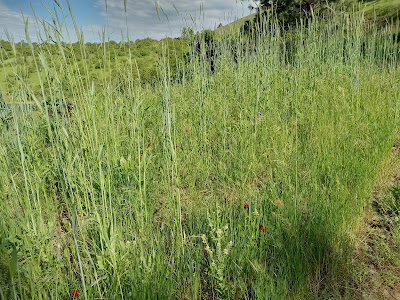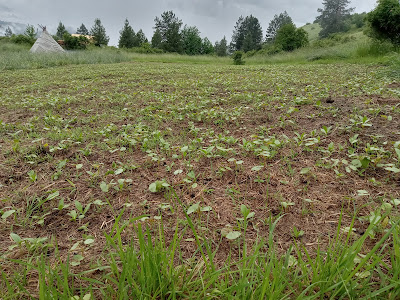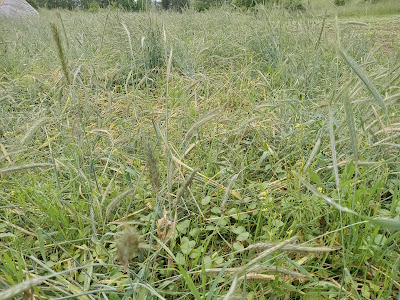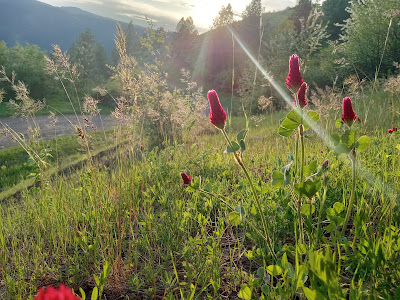Since my last food plot update at the beginning of the year we have had some very interesting and mostly beneficial weather conditions and my food plots have really flourished up until now. My large test plot where I used the black tarp to kill the sod last year has done especially well.
After planting it last fall with my cool season annual mix it germinated and grew very well before winter hit. Then we had a long cold snowy winter with continuous snow cover until early March. Then we had a very cool and wet spring up until mid June and because of the abundant moisture this plot performed amazingly. By late April this plot was getting quite dense especially with the winter rye and camelina. And then over the next month through the first week of June this plot exploded. In this short amount of time the rye grew from about 1 foot tall to about 6 feet and the Camelina also did exceptionally well.
The rest of the species in the mix such as the various clovers and the hairy/woolypod vetch didn't do quite as well which I mainly attribute to too low of a seeding rate, being overly browsed by deer and also by being shaded out by the rye and camelina. However the few clovers and vetchs that did survive seemed to be thriving. Only a small handful of the rapeseed survived and I believe that was because of a too short of a season after germination before going into winter dormancy as well as poor winter hardiness so I will probably not include this in my future mixes. I also didn't see any common vetch that survived in this plot so I will also remove it from future mixes. The only clover I didn't see in this plot was the persian clover so I will probably not include it either. And the rose clover was fairly sparse in this plot as well so I will not include it in my mixes for areas with higher quality soils, but it did thrive in my road cut plot so I will keep it in mixes for poorer soils. So for my future cool season mix I will likely narrow it down to just winter rye and winter camelina, both at lower seeding rates, as well as crimson clover, balansa clover, arrowleaf clover and hairy/woolypod vetch all with higher seeding rates.
In early June I decided to plant an annual warm season mix, which included soybeans, sunflowers, safflower, buckwheat, sorghum, and 3 types of millet. I planted it into last year's tarped plot that had the cool season mix as well as in an adjacent plot that I tarped to kill the sod from March until June this spring. For the new tarped plot I used the harrow to break up the dead sod and broadcast my summer annual mix into and harrowed again after broadcasting. So far this plot has had very good germination with my mix and I expect it to do very well over the summer. The only problem I see in this plot is that some of the sod grass was starting to come back so I will probably need to keep the tarp down throughout the summer in new future plots.
Next to this in my winter annual plot I broadcast my summer mix into the standing cool season mix and then crimped it down on top of the new seed. I probably crimped it down too early because a lot of the rye hadn't even begun flowering yet and after I crimped it a lot of it stood back up or regrew and proceeded to flower and set seed. However, I'm not too worried about this because it appears a lot of my summer mix still germinated and is growing well even with the shade from the partially standing rye. In the future though I should try to wait at least until flowering to crimp the rye so it gets a better termination rate.
In my road cut plot last fall's cool season mix did fairly well, especially the clovers and hairy/woolypod vetch. I also broadcast several perennial mixes here in March, April and May and most seem to be doing pretty well. My biggest mix was a frost seeding mix I planted in March which included red clover, Aberlasting Hybrid clover, birdsfoot trefoil, small burnet, forage chicory, forage plantain, blue flax and sweet clover. In April my mix included crownvetch and yellow alfalfa. And finally in May I planted cicer milkvetch. Our wet spring should help these mixes establish well and hopefully by this time next year these mixes will be flourishing. I also did a small test plot of just cicer milkvetch in a spot with better soil since I think it will be a key component in my future pasture cropping mix that I decided to delay planting until next year.
Last year I also planted the cool season mix on some of the poorer soil areas that had been covered in invasive star thistles and other weeds. Like the previous year I mowed the starthistle in the summer during flowering then broadcast my cool season mix in September. These areas had some growth but overall they did not perform well. I think that because of the abundant weeds in the area, that were unaffected by my summer mowing, my mix was outcompeted, especially by invasive grasses, and therefore grew poorly. So in the future I don't think I will reseed these areas with my mixes until I have terminated all the plants using a black plastic covering as this seems to be the best method to terminate grasses and weeds on my property. I will, however, probably use livestock such as my geese and eventually sheep to improve the soil in these areas and eventually I will use the black plastic and put in new plots but that will be a fairly long term plan. For now I will keep it in more of a fallow state until I can put my animals onto it.
Finally my roadside plot that I was using weed-eating and a cool season cover crop mix to kill off the starthistle seems to be doing very well. There is still some starthistle in it, but it is way less than last year. This year I will once again weedeat it at flowering to prevent the starthistle from going to seed. I think my future plans for this area is to remove the medium and large rocks here during the winter so I can mow it with a lawn mower next year and I will likely frost seed it with a perennial mix so that it will be easier to manage.
So that is how my food plots are doing so far this year. It's interesting to see how my mixes are doing with these wildly varying weather conditions over the past few years. Last year we had a record hot and dry spring and this year's spring was the exact opposite with very cold and wet conditions. But these variations really help me test how well my seed mixes are adapted to my climate and I'm really starting to understand their requirements and narrow down the best performers. Doing these experiments I am continuously learning about how to provide wild game with excellent forage all year long and it continues to be a very rewarding endeavor and I'm looking forward to what else I will learn in the future.








